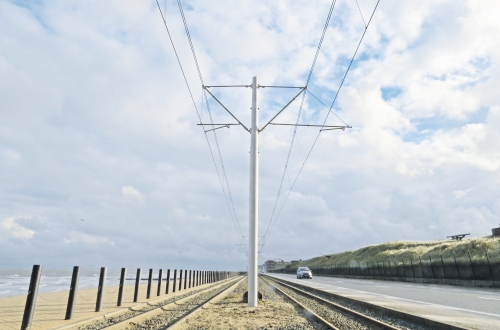AVG, which operates a 280km light rail network, is testing the new masts on a turning loop in Ettlingen near Karlsruhe with installation of the test infrastructure due to be completed by September. A variety of cantilevers, carrying the contact wires, will be mounted on the GRP masts.
The masts are around 11m tall and weigh approximately 800kg, which AVG says simplifies transport and installation. It says their ecological impact is better than that of conventional concrete and steel masts, as production consumes approximately a third less energy, and while the current price for GRP masts is still higher than steel and concrete masts, AVG expects that to change.
Powerlines has been testing the GRP masts in all weather conditions on a coastal tramline in Ostend, Belgium, since 2013, where the masts are exposed to the harsh North Sea climate and a high concentration of salt in the sea air.
“Since GRP masts are not subject to rust, they have a notably longer working life than masts made of steel,” says AVG project manager, Mr Peter Masino. “They need to be replaced far less often, eliminating the usual follow-up costs for maintenance. Once the long-term tests have been completed successfully and the GRP masts have gone into serial production, unit prices will drop significantly.”
“GRP masts are particularly beneficial in terms of work safety, since the masts themselves provide insulation and prevent electricity from being conducted from catenaries,” says Powerlines Group CEO, Mr Gerhard Ehringer. “Hence, the overhead power line systems require a significantly smaller number of insulators, if any, since earthing is usually not required.”

